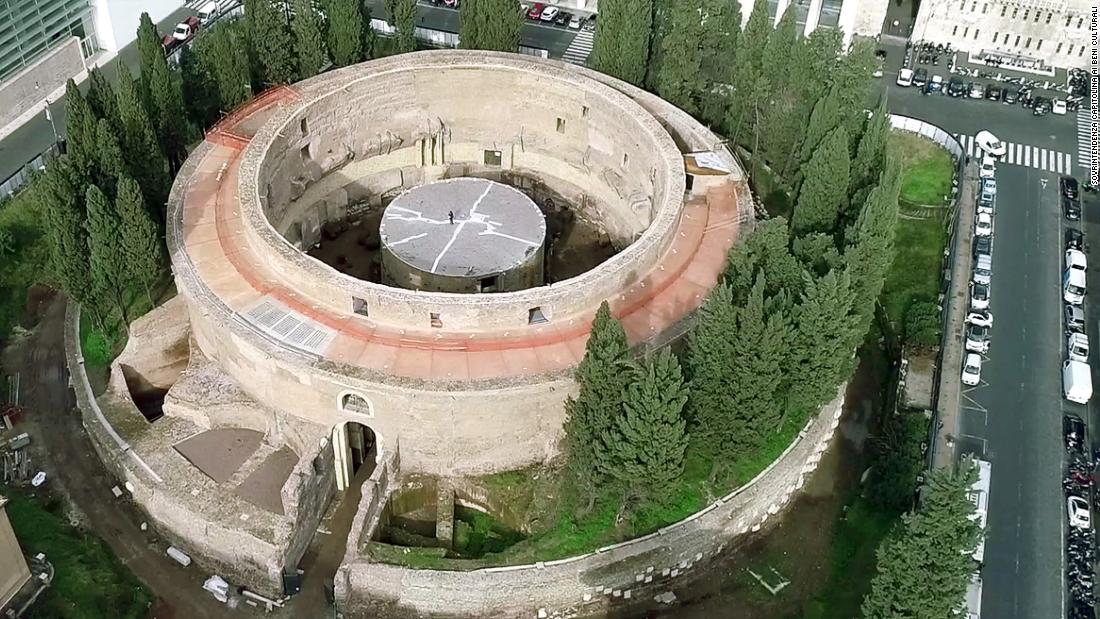(CNN) – He was the first Roman emperor, who replaced Julius Caesar and built an empire that would extend from the United Kingdom to Egypt, boasting on his deathbed that “I found Rome built of bricks and left it with marble”.
But Emperor Augustus was not exactly paid in kind when he died in 14 CE.
His tomb – a huge circular mausoleum, the largest in the city when it was built – was abandoned for centuries.
With its fallen roof and the cypresses planted around it growing wild, it has long been away from the carefully preserved Colosseum and Roman Forum.
In fact, for much of the past 80 years, it was closed to the public, with brief openings in 2000 to celebrate the city’s Jubilee year and, again, before being closed in 2007 for archaeological investigations.
It was expected to reopen in 2014, to mark 2,000 years since Augusto’s death. In the end, however, with the conservation works still in progress, it opened on the same day.
But finally, a 13-year restoration has come to an end and is expected to open to the public in March 2021.
A complete renovation

After decades of abandonment, it will be open again to the public.
Sovrintendenza Capitolina ai Beni Culturali
Restorations, completed in two stages, cost more than € 10 million ($ 12 million). The first phase, partially funded by the Italian Ministry of Cultural Heritage and Activities and by the Roman authorities, was completed in 2019. It supervised the restoration of the monument.
The second phase, financed by Fondazione TIM, the social arm of Telecom Italia, in the amount of € 6 million ($ 7,300,000), focused on the internal spaces and on its preparation for tours.
Huge structural works were carried out to protect the mausoleum and a spiral staircase leading to the monument’s roof was rebuilt.
Fondazione TIM also financed the restoration of the cemetery and the landscaping around the mausoleum.
Even the external square, Piazza Augusto Imperatore, is being renovated. So far, the mausoleum has been something of a roundabout, with cars parked around it. The works are due to finish in December 2021.
Great neighbors

The mausoleum was originally as big as the Pinciana hill.
Sovrintendenza Capitolina ai Beni Culturali
In 2006, the old pavilion around it was replaced by a glass and steel structure by architect Richard Meier, which is more of a work of art in itself. The altar is now visible from the Tiber River, with the mausoleum behind it.
Augustus had big plans for his grave. The emperor – who was born in 63 BC and assumed power in 14 CE – had his work started in 28 BC, after his victory over Marco Antonio and Cleopatra at the Battle of Actium, when “Augusto” was just Octavian – his name before become emperor.
A gigantic marble-clad tomb

The interiors have been severely damaged over the centuries.
Sovrintendenza Capitolina ai Beni Culturali
Built for him and his family, it is the largest circular tomb in the ancient world, with a diameter of almost 90 meters and a height of at least 45 meters, so it can be deduced from the remains. Only a third of the original monument survived.
Its gigantic size made it almost as big as the nearby Pinciana hill, and it was situated close to the Tiber in order to be visible from most of the city.
Although today it appears to be made of bricks, originally these walls were covered with travertine marble, of which only traces remain today.
It is believed to have served as a tomb for more than 100 years, before records were lost. It was mentioned below in the 10th century.
From a fortress to an amphitheater

The mausoleum seen in 1963, with the Tiber beyond it.
Museo di Roma, Archivio Fotografico
In the medieval period, a fortress was built on the remains, but it was destroyed in 1241. Then, the structure was gradually dismantled, with the marble being removed for use as a building material.
In the 16th century, the owners of a nearby palace transformed the interior of the tomb into a garden. In the 1780s it was being used as an amphitheater, with bullfights and jousting on display. In the 19th century it was covered by a glass dome and used for theater shows; in the 20th century it already functioned as a concert hall, the Auditório Augusteo.
Only in 1936 did his new life come to an end, when the fascist regime – which sought to excavate and preserve the city’s heritage, in an attempt to align itself with Ancient Rome – demolished the dome and modern buildings, to unveil the tomb yet again. turn.
Restoration work was interrupted during World War II and resumed in the 1950s.
